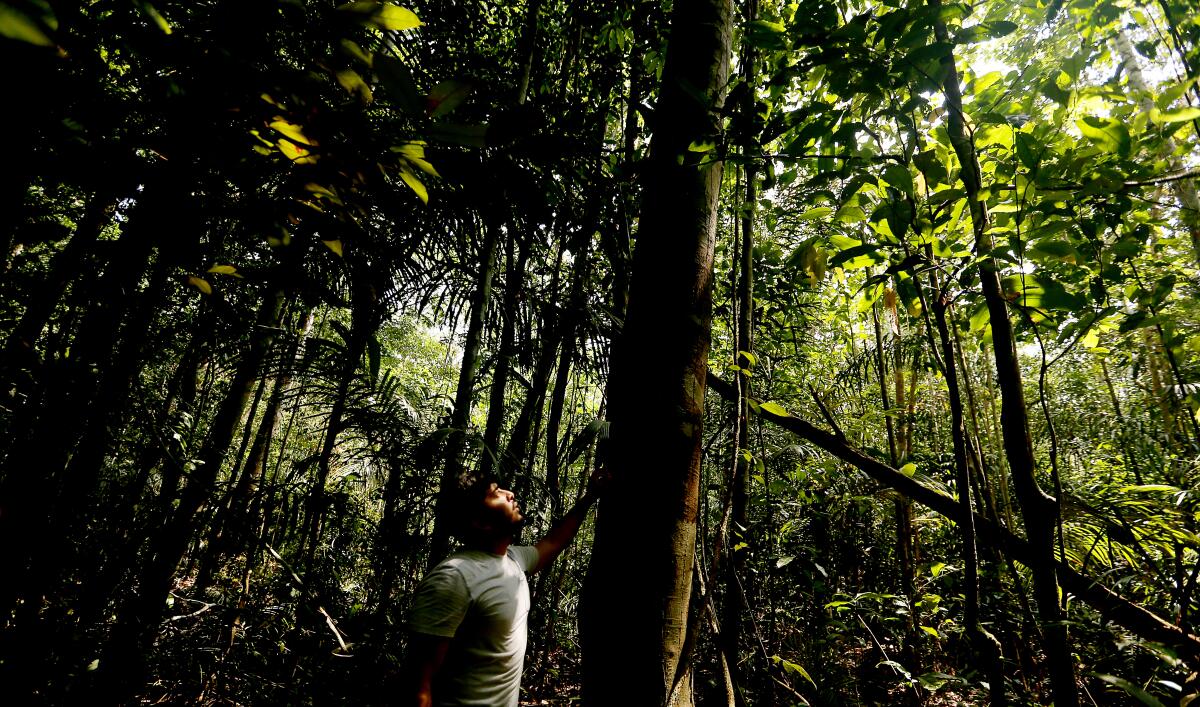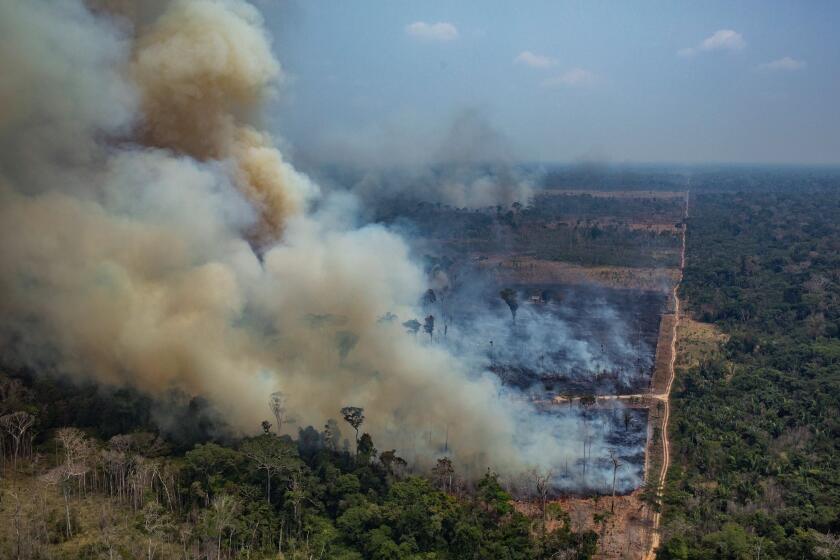Tropical forests may be warming to a point where plant photosynthesis fails, study warns

- Share via
Teeming with life and stretching across multiple continents, tropical forests are often called the “lungs of the planet” because of their ability to suck up climate-warming carbon dioxide and exhale oxygen — a process known as photosynthesis.
But even as these critical ecosystems work with Earth’s oceans to help scrub CO2 from the atmosphere and give us air to breathe, tropical forests have long faced growing threats from fires, poaching and deforestation.
Now, new research suggests that humanity’s unchecked burning of fossil fuels may pose an entirely new danger.
In a study published recently in the journal Nature, scientists concluded that tropical forests could be drawing closer to the temperature threshold where leaves lose the ability to create life-sustaining energy by combining CO2, water and sunlight.
“We have known for a long time that when leaves reach a certain temperature, their photosynthetic machinery breaks down,” said Gregory R. Goldsmith, a study co-author and assistant professor of biological sciences at Chapman University.
For California to successfully fight climate change, the state’s politicians, business leaders and millions of residents will need to work a lot harder.
“But this study is really the first study to establish how close tropical forest canopies may be to these limits,” he told reporters recently.
Researchers said that a leaf’s ability to perform photosynthesis — and produce oxygen as a byproduct — is permanently lost above 116 degrees Fahrenheit and results in its death. New research discovered that some tropical leaves are already surpassing that critical temperature.
Currently, only about 0.01% of all sun-exposed leaves in upper tropical forest canopies exceed that threshold in a typical year, researchers found. But their modeling warns that if nothing is done to curb global warming, that percentage will increase in the future, and rampant leaf death and tree loss could possibly occur if tropical forests warm an additional 7.02 degrees — give or take 0.9 degrees.
“Photosynthesis typically starts to decrease at much lower temperatures than 116 degrees, but that is fully reversible,” said Martijn Slot, a study author and forest ecologist with the Smithsonian Tropical Research Institute. “When conditions improve, photosynthesis resumes. Above 116 degrees, the damage is irreversible.”
The paper’s conclusion comes at a time when researchers are scrutinizing the affects of extreme heat on California trees — along with drought, fire and disease.
Many plants in some regions of the state are already reaching critical temperature thresholds, such as in the Mojave Desert, said Louis Santiago, a professor of physiological ecology at UC Riverside, who was not involved in the study. “We know many of our leaves out there are getting extremely hot and they’re not going to be photosynthesizing at those temperatures,” he said.
There are also regions along California’s coast that are vulnerable to hotter weather, such as redwood forests. “These high temperature events are telling, because if there’s an increase, we would see periods where these coastal plants would not be able to photosynthesize,” Santiago said.
The Nature study comes with some uncertainties. Researchers note that the 116-degree tipping-point may vary among tree species. They also don’t know if relative humidity affects the temperature threshold, or how the death of individual leaves may influence a tree’s mortality.
Tropical forests — which include tropical rainforests such as the Amazon — are vital carbon sinks, and represent about 46% of the Earth’s living carbon pool and nearly 12% of the world’s soil carbon pool, according to one study.
Trees in tropical forests cool the planet not only by sequestering carbon, but also by releasing chemicals that reflect heat energy and form clouds, according to researchers. Tropical forests are also home to most of the world’s biodiversity. Half of the Earth’s plant and animal species live in these rich regions.
Unfortunately, tropical forests are also more susceptible to small changes in temperature — unlike forests in other parts of the world, such as California.
Mean temperatures in tropical forests are generally high, and their seasonal changes are minimal, so even small shifts can exert significant impact on their plant species, the study authors said.
A Brazilian nonprofit has created a new model for land ownership that welcomes local people and scientists to collaborate in preserving the Amazon.
In an effort to better understand the way temperature affects photosynthesis — and how close today’s tropical forests are to a potential tipping point — researchers turned to orbiting technology, and traveled to a number of evergreen jungles.
Using a thermal instrument on the International Space Station called ECOSTRESS, researchers measured land surface temperatures across various tropical regions, including Brazil, Australia and Puerto Rico, between 2018 and 2020 to estimate peak upper canopy temperatures.
They found that midday peaks averaged approximately 93.2 degrees during dry periods, but a small percentage surpassed 104 degrees.
Next came the challenging task of climbing to the upper canopies of trees, painstakingly installing sensors on leaves to measure their individual temperatures, and later heating them with black plastic or portable heaters by an additional 3.6; 5.4; and 7.2 degrees to observe their response.
They found that leaf temperatures — and the threshold for photosynthetic failure — did not increase in a linear fashion. Some leaves could fall into distress at lower air temperatures, depending on other factors such as drought.
The reason for this is that when the atmosphere warms, most leaves cool themselves by releasing water — a process called transpiration. But when the air and soil are so dry that they can’t meet demand, a tree will eventually close the stomata, or pores, on its leaves to avoid losing precious water. Heat then accumulates in the leaf, and if it gets too high, metabolic function collapses and the leaf dies.
This phenomenon was particularly concerning to researchers because it suggested that leaf temperatures could be higher than the measured air temperature — particularly at the top of a forest canopy where they are exposed to direct sunlight. “You heat the air by less than 2, 3 degrees [Celsius], and the actual upper temperature of these leaves goes up by 8 degrees [Celsius],” said Christopher E. Doughty, the study’s lead author and associate professor of ecoinformatics at Northern Arizona University.
The death of a small number of leaves could have a profound cascading effect at higher temperatures, Doughty said. If enough leaves die, they reduce the cooling of an entire branch. If enough branches die, the entire tree can die. If enough trees die, a forest is imperiled.
“Even though a small percentage of leaves are currently doing this ... our best guess is that a 4-degree C [7.2 Fahrenheit] increase in air temperature, and there could be some serious issues for certain tropical forests,” he said.
Land-grabbers in Brazil are slashing and burning the Amazon rainforest. If too many trees are removed, Earth’s climate could lose a critical buffer.
Slot said that some tree species are better at withstanding heat. Prior studies indicate that canopy shape and certain leaf characteristics — such as size and thickness — make some trees better adapted to cope with hotter temperatures.
How leaves are oriented, and the way sunlight and wind affect them are also important, but Slot said there was currently no way to measure those factors on a large scale.
Santiago, who is also a researcher with the Smithsonian Tropical Research Institute, said the findings were cause for concern. “The big question is: At what point would we see a large enough number of leaves stop doing this vital function and start having an effect on global carbon cycles? ... [T]he ramifications of this are huge.”
While the authors emphasized the uncertainties within their study, if their findings are true, they wrote, crossing the 116-degree temperature brink “is within the range of our most pessimistic future climate change scenarios.”
“The combination of climate change and local deforestation may already be placing the hottest tropical forest regions close to, or even beyond, a critical thermal threshold,” authors wrote. “Therefore, our results suggest that the combination of ambitious climate change mitigation goals and reduced deforestation can ensure that these important realms of carbon, water and biodiversity stay below thermally critical thresholds.”
But with the world’s efforts to transition to renewable energy, Doughty said there is reason for hope.
“I feel optimistic,” he said. “It doesn’t seem like we’re going to get to that point. But it is, of course, possible.”










